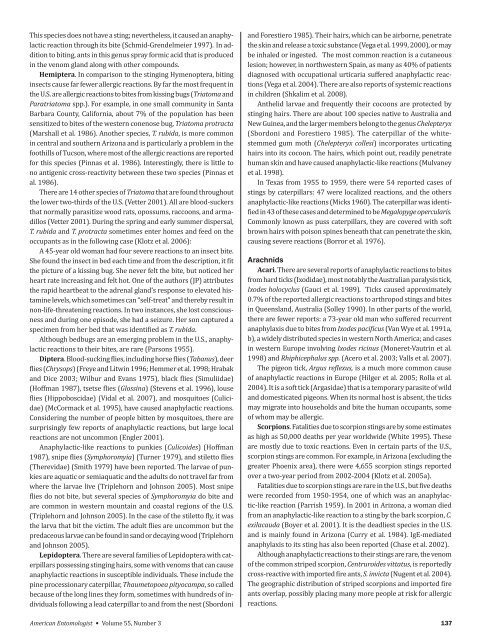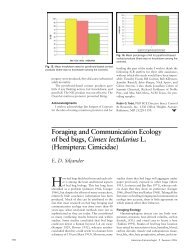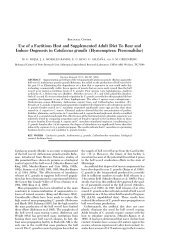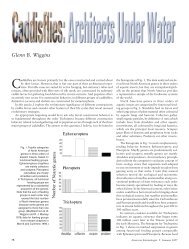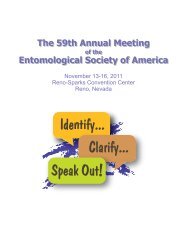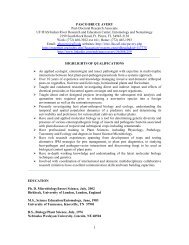to Arthropod Bites and Stings - Entomological Society of America
to Arthropod Bites and Stings - Entomological Society of America
to Arthropod Bites and Stings - Entomological Society of America
You also want an ePaper? Increase the reach of your titles
YUMPU automatically turns print PDFs into web optimized ePapers that Google loves.
This species does not have a sting; nevertheless, it caused an anaphylactic<br />
reaction through its bite (Schmid-Grendelmeier 1997). In addition<br />
<strong>to</strong> biting, ants in this genus spray formic acid that is produced<br />
in the venom gl<strong>and</strong> along with other compounds.<br />
Hemiptera. In comparison <strong>to</strong> the stinging Hymenoptera, biting<br />
insects cause far fewer allergic reactions. By far the most frequent in<br />
the U.S. are allergic reactions <strong>to</strong> bites from kissing bugs (Tria<strong>to</strong>ma <strong>and</strong><br />
Paratria<strong>to</strong>ma spp.). For example, in one small community in Santa<br />
Barbara County, California, about 7% <strong>of</strong> the population has been<br />
sensitized <strong>to</strong> bites <strong>of</strong> the western conenose bug, Tria<strong>to</strong>ma protracta<br />
(Marshall et al. 1986). Another species, T. rubida, is more common<br />
in central <strong>and</strong> southern Arizona <strong>and</strong> is particularly a problem in the<br />
foothills <strong>of</strong> Tucson, where most <strong>of</strong> the allergic reactions are reported<br />
for this species (Pinnas et al. 1986). Interestingly, there is little <strong>to</strong><br />
no antigenic cross-reactivity between these two species (Pinnas et<br />
al. 1986).<br />
There are 14 other species <strong>of</strong> Tria<strong>to</strong>ma that are found throughout<br />
the lower two-thirds <strong>of</strong> the U.S. (Vetter 2001). All are blood-suckers<br />
that normally parasitize wood rats, opossums, raccoons, <strong>and</strong> armadillos<br />
(Vetter 2001). During the spring <strong>and</strong> early summer dispersal,<br />
T. rubida <strong>and</strong> T. protracta sometimes enter homes <strong>and</strong> feed on the<br />
occupants as in the following case (Klotz et al. 2006):<br />
A 45-year old woman had four severe reactions <strong>to</strong> an insect bite.<br />
She found the insect in bed each time <strong>and</strong> from the description, it fit<br />
the picture <strong>of</strong> a kissing bug. She never felt the bite, but noticed her<br />
heart rate increasing <strong>and</strong> felt hot. One <strong>of</strong> the authors (JP) attributes<br />
the rapid heartbeat <strong>to</strong> the adrenal gl<strong>and</strong>’s response <strong>to</strong> elevated histamine<br />
levels, which sometimes can “self-treat” <strong>and</strong> thereby result in<br />
non-life-threatening reactions. In two instances, she lost consciousness<br />
<strong>and</strong> during one episode, she had a seizure. Her son captured a<br />
specimen from her bed that was identified as T. rubida.<br />
Although bedbugs are an emerging problem in the U.S., anaphylactic<br />
reactions <strong>to</strong> their bites, are rare (Parsons 1955).<br />
Diptera. Blood-sucking flies, including horse flies (Tabanus), deer<br />
flies (Chrysops) (Freye <strong>and</strong> Litwin 1996; Hemmer et al. 1998; Hrabak<br />
<strong>and</strong> Dice 2003; Wilbur <strong>and</strong> Evans 1975), black flies (Simuliidae)<br />
(H<strong>of</strong>fman 1987), tsetse flies (Glossina) (Stevens et al. 1996), louse<br />
flies (Hippoboscidae) (Vidal et al. 2007), <strong>and</strong> mosqui<strong>to</strong>es (Culicidae)<br />
(McCormack et al. 1995), have caused anaphylactic reactions.<br />
Considering the number <strong>of</strong> people bitten by mosqui<strong>to</strong>es, there are<br />
surprisingly few reports <strong>of</strong> anaphylactic reactions, but large local<br />
reactions are not uncommon (Engler 2001).<br />
Anaphylactic-like reactions <strong>to</strong> punkies (Culicoides) (H<strong>of</strong>fman<br />
1987), snipe flies (Symphoromyia) (Turner 1979), <strong>and</strong> stilet<strong>to</strong> flies<br />
(Therevidae) (Smith 1979) have been reported. The larvae <strong>of</strong> punkies<br />
are aquatic or semiaquatic <strong>and</strong> the adults do not travel far from<br />
where the larvae live (Triplehorn <strong>and</strong> Johnson 2005). Most snipe<br />
flies do not bite, but several species <strong>of</strong> Symphoromyia do bite <strong>and</strong><br />
are common in western mountain <strong>and</strong> coastal regions <strong>of</strong> the U.S.<br />
(Triplehorn <strong>and</strong> Johnson 2005). In the case <strong>of</strong> the stilet<strong>to</strong> fly, it was<br />
the larva that bit the victim. The adult flies are uncommon but the<br />
predaceous larvae can be found in s<strong>and</strong> or decaying wood (Triplehorn<br />
<strong>and</strong> Johnson 2005).<br />
Lepidoptera. There are several families <strong>of</strong> Lepidoptera with caterpillars<br />
possessing stinging hairs, some with venoms that can cause<br />
anaphylactic reactions in susceptible individuals. These include the<br />
pine processionary caterpillar, Thaume<strong>to</strong>poea pityocampa, so called<br />
because <strong>of</strong> the long lines they form, sometimes with hundreds <strong>of</strong> individuals<br />
following a lead caterpillar <strong>to</strong> <strong>and</strong> from the nest (Sbordoni<br />
<strong>and</strong> Forestiero 1985). Their hairs, which can be airborne, penetrate<br />
the skin <strong>and</strong> release a <strong>to</strong>xic substance (Vega et al. 1999, 2000), or may<br />
be inhaled or ingested. The most common reaction is a cutaneous<br />
lesion; however, in northwestern Spain, as many as 40% <strong>of</strong> patients<br />
diagnosed with occupational urticaria suffered anaphylactic reactions<br />
(Vega et al. 2004). There are also reports <strong>of</strong> systemic reactions<br />
in children (Shkalim et al. 2008).<br />
Anthelid larvae <strong>and</strong> frequently their cocoons are protected by<br />
stinging hairs. There are about 100 species native <strong>to</strong> Australia <strong>and</strong><br />
New Guinea, <strong>and</strong> the larger members belong <strong>to</strong> the genus Chelepteryx<br />
(Sbordoni <strong>and</strong> Forestiero 1985). The caterpillar <strong>of</strong> the whitestemmed<br />
gum moth (Chelepteryx collesi) incorporates urticating<br />
hairs in<strong>to</strong> its cocoon. The hairs, which point out, readily penetrate<br />
human skin <strong>and</strong> have caused anaphylactic-like reactions (Mulvaney<br />
et al. 1998).<br />
In Texas from 1955 <strong>to</strong> 1959, there were 54 reported cases <strong>of</strong><br />
stings by caterpillars: 47 were localized reactions, <strong>and</strong> the others<br />
anaphylactic-like reactions (Micks 1960). The caterpillar was identified<br />
in 43 <strong>of</strong> these cases <strong>and</strong> determined <strong>to</strong> be Megalopyge opercularis.<br />
Commonly known as puss caterpillars, they are covered with s<strong>of</strong>t<br />
brown hairs with poison spines beneath that can penetrate the skin,<br />
causing severe reactions (Borror et al. 1976).<br />
Arachnids<br />
Acari. There are several reports <strong>of</strong> anaphylactic reactions <strong>to</strong> bites<br />
from hard ticks (Ixodidae), most notably the Australian paralysis tick,<br />
Ixodes holocyclus (Gauci et al. 1989). Ticks caused approximately<br />
0.7% <strong>of</strong> the reported allergic reactions <strong>to</strong> arthropod stings <strong>and</strong> bites<br />
in Queensl<strong>and</strong>, Australia (Solley 1990). In other parts <strong>of</strong> the world,<br />
there are fewer reports: a 73-year old man who suffered recurrent<br />
anaphylaxis due <strong>to</strong> bites from Ixodes pacificus (Van Wye et al. 1991a,<br />
b), a widely distributed species in western North <strong>America</strong>; <strong>and</strong> cases<br />
in western Europe involving Ixodes ricinus (Moneret-Vautrin et al.<br />
1998) <strong>and</strong> Rhiphicephalus spp. (Acero et al. 2003; Valls et al. 2007).<br />
The pigeon tick, Argus reflexus, is a much more common cause<br />
<strong>of</strong> anaphylactic reactions in Europe (Hilger et al. 2005; Rolla et al.<br />
2004). It is a s<strong>of</strong>t tick (Argasidae) that is a temporary parasite <strong>of</strong> wild<br />
<strong>and</strong> domesticated pigeons. When its normal host is absent, the ticks<br />
may migrate in<strong>to</strong> households <strong>and</strong> bite the human occupants, some<br />
<strong>of</strong> whom may be allergic.<br />
Scorpions. Fatalities due <strong>to</strong> scorpion stings are by some estimates<br />
as high as 50,000 deaths per year worldwide (White 1995). These<br />
are mostly due <strong>to</strong> <strong>to</strong>xic reactions. Even in certain parts <strong>of</strong> the U.S.,<br />
scorpion stings are common. For example, in Arizona (excluding the<br />
greater Phoenix area), there were 4,655 scorpion stings reported<br />
over a two-year period from 2002-2004 (Klotz et al. 2005a).<br />
Fatalities due <strong>to</strong> scorpion stings are rare in the U.S., but five deaths<br />
were recorded from 1950-1954, one <strong>of</strong> which was an anaphylactic-like<br />
reaction (Parrish 1959). In 2001 in Arizona, a woman died<br />
from an anaphylactic-like reaction <strong>to</strong> a sting by the bark scorpion, C.<br />
exilacauda (Boyer et al. 2001). It is the deadliest species in the U.S.<br />
<strong>and</strong> is mainly found in Arizona (Curry et al. 1984). IgE-mediated<br />
anaphylaxis <strong>to</strong> its sting has also been reported (Chase et al. 2002).<br />
Although anaphylactic reactions <strong>to</strong> their stings are rare, the venom<br />
<strong>of</strong> the common striped scorpion, Centruroides vittatus, is reportedly<br />
cross-reactive with imported fire ants, S. invicta (Nugent et al. 2004).<br />
The geographic distribution <strong>of</strong> striped scorpions <strong>and</strong> imported fire<br />
ants overlap, possibly placing many more people at risk for allergic<br />
reactions.<br />
<strong>America</strong>n En<strong>to</strong>mologist • Volume 55, Number 3 137


